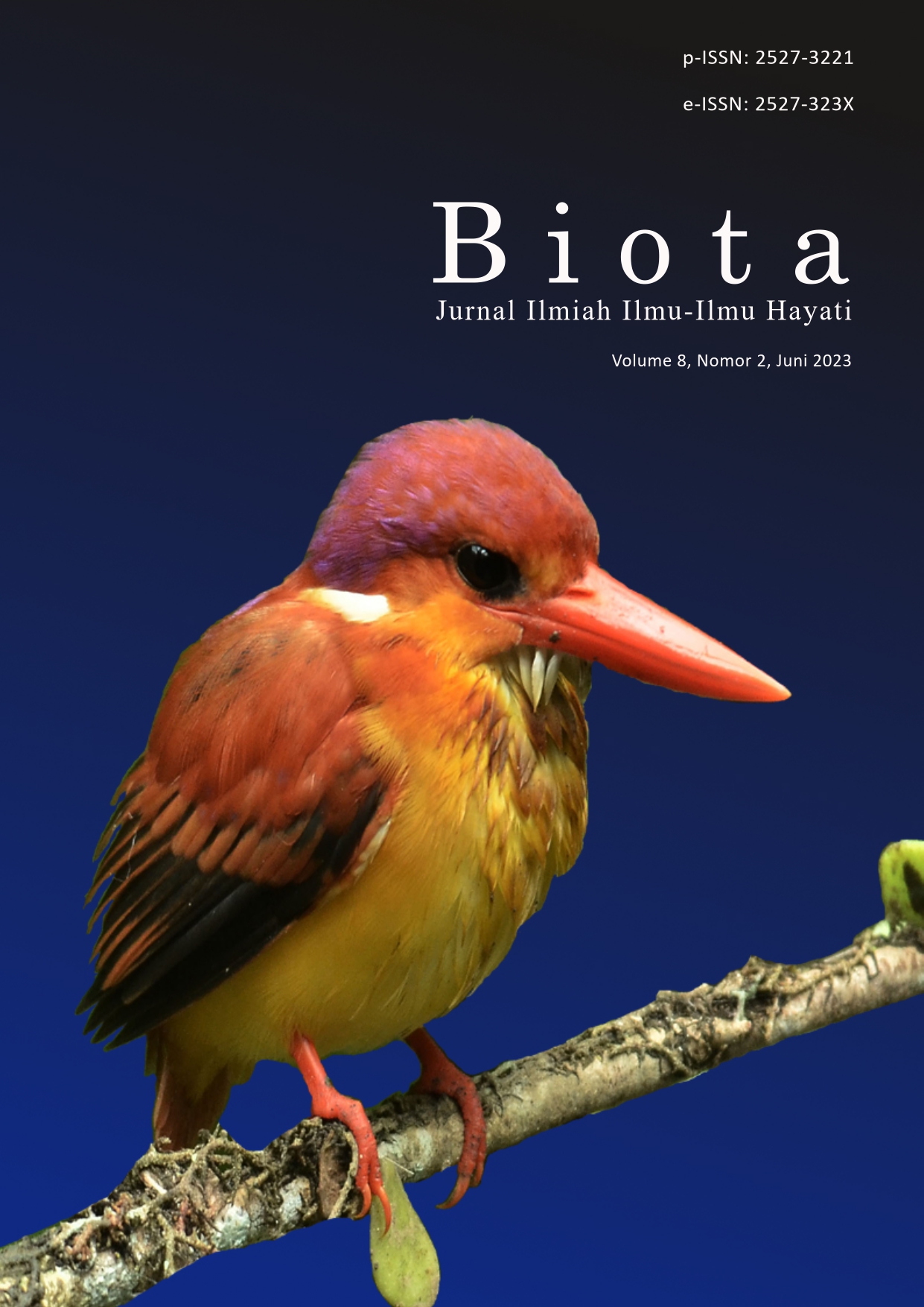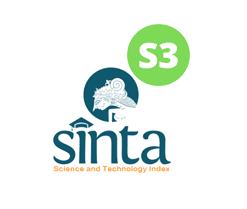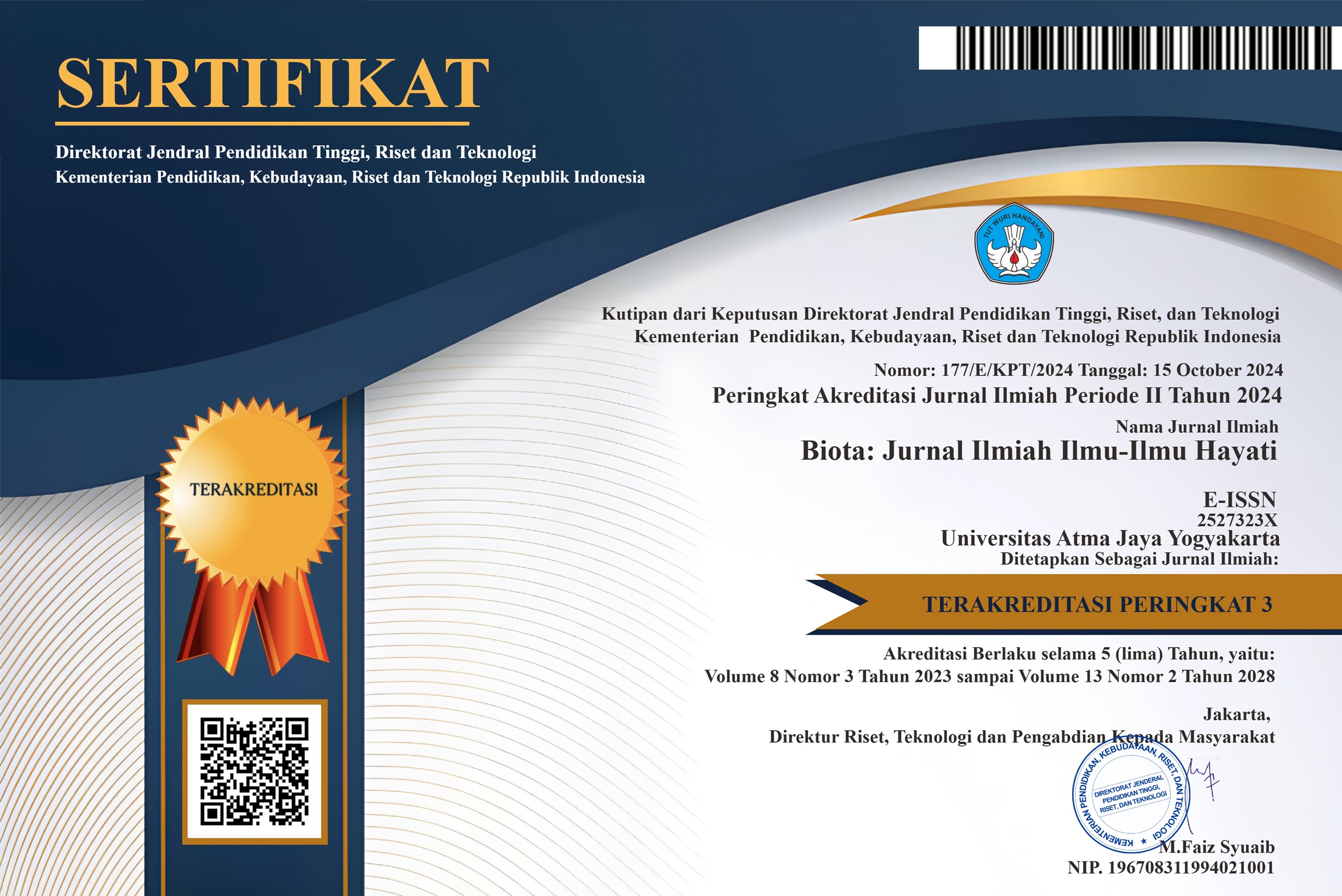Ekstraksi dan Identifikasi Kandungan Senyawa Bioaktif Daun Saga Rambat (Abrus precatorius)
DOI:
https://doi.org/10.24002/biota.v8i2.6417Keywords:
Abrus precatorius, daun saga rambat, ekstraksi, gas chromatography – mass spectroscopy, senyawa bioaktifAbstract
Daun saga rambat telah banyak digunakan oleh masyarakat untuk mengobati beragam jenis penyakit. Bioaktivitas ini berkaitan dengan kandungan senyawa metabolit. Selama ini, aktivitas farmakologis daun saga rambat di masyarakat masih berdasarkan bukti empiris. Selain itu, informasi terkait kandungan senyawa bioaktif di daun saga rambut masih terbatas. Pada penelitian ini senyawa metabolit yang terkandung di dalam daun saga rambat diekstrak dan diidentifikasi. Senyawa metabolit diekstraksi dengan metode maserasi menggunakan tiga jenis pelarut, yaitu etanol, metanol dan air. Senyawa pada ketiga ekstrak diidentifikasi dengan gas chromatography – mass spectroscopy (GC-MS). Hasil analisis menunjukkan terdapat 23 senyawa di ekstrak etanol, 9 senyawa di ekstrak metanol, dan 9 senyawa di ekstrak air. Diantara seluruh senyawa pada ketiga ekstrak tersebut, senyawa yang memiliki konsentrasi tinggi adalah (1) octadecenyl aldehyde; (2) n-octadecanoic acid; (3) methyl 6,7-methylene octadecanoate (from trans); dan (4) pentadecanoic acid, 14-methyl-, methyl ester. Dari hasil penelusuran pustaka, keempat senyawa tersebut memiliki aktivitas antioksidan, antibakteri, antivirus dan antiinflamasi. Oleh karena itu, daun saga rambat memiliki potensi untuk dikembangkan sebagai obat herbal dalam pengatasan penyakit-penyakit yang disebabkan oleh bakteri, radikal bebas, virus, dan inflamasi.
References
Adams R.P. (2007). Identification Of Essential Oil Components by Gas Chromatography/Mass Spectrometry, 4th Edition. Allured Publishing Corporation. Illinois
Alqahtani F.Y., Aleanizy F.S., Mahmoud A.Z., Farshori N.N., Alfaraj R., Al-sheddi E.S. & Alsarra I.A. (2019). Chemical composition and antimicrobial, antioxidant, and anti-inflammatory activities of lepidium sativum seed oil. Saudi Journal of Biological Sciences 26(5): 1089-1092.
Bhakta S. & Das S.K. (2020). The medicinal values of abrus precatorius: a review study. Journal of Advanced Biotechnology and Experimental Therapeutics 3(2): 84-91.
Bhatia M., Siddiqui N.A. & Gupta S. (2013). Abrus Precatorius (L.): An evaluation of traditional herb. Indo American Journal of Pharmaceutical Research 3(4): 3295-3315.
Boye A., Barku V.Y.A., Acheampong D.O. & Ofori E.G. (2021). Abrus precatorius leaf extract reverses alloxan/nicotinamide-induced diabetes mellitus in rats through hormonal (insulin, GLP-1, and glucagon) and enzymatic (α-amylase/α-glucosidase) modulation. BioMed Research International 2021(9920826): 1-17.
Boye A., Acheampong D.O., Gyamerah E.O., Asiamah E.A., Addo J.K., Mensah D.A., Brah A.S. & Ayiku P.J. (2020). Glucose lowering and pancreato-protective effects of Abrus Precatorius (L.) leaf extract in normoglycemic and STZ/nicotinamide – induced diabetic rats. Journal of Ethnopharmacology 258(112918): 1-14.
Gul M.Z., Ahmad F., Kondapi A.K., Qureshi I.A. & Ghazi I.A. (2013). Antioxidant and antiproliferative activities of abrus precatorius leaf extracts - an in vitro study. BMC Complementary and Alternative Medicine 13(53): 1-12.
Jain A., Sinha P., Jain A. & Vavilala S. (2015). Estimation of flavonoid content, polyphenolic content and antioxidant potential of different parts of abrus precatorius (L.). International Journal of Pharmacy and Pharmaceutical Sciences 7(8): 157-163.
Kitson F.G., Larsen B.S. & McEwen C.N. (1996). Gas chromatography and mass spectrometry: A Practical Guide. Academic Press, Inc. U.S.A.
Kumar P., Senthamilselvi S. & Govindaraju M. (2013). GC-MS profiling and antibacterial activity of sargassum tennerrimum. Journal of Pharmacy Research 6: 88-92.
Linton R.E.A., Jerah S.L. & Ahmad I.B. (2013). The effect of combination of octadecanoic acid, methyl ester and ribavirin against measles virus. International Journal of Scientific and Technology Research 2(10): 181-184.
Ohiri R.C. & Bassey E.E. (2016). Gas chromatography−mass spectrometry analysis of constituent oil from lingzhi or reishi medicinal mushroom, ganoderma lucidum (agaricomycetes), from Nigeria. International Journal of Medicinal Mushrooms 8(4): 365-369.
Palvai V.R., Mahalingu S. & Uroo, A. (2014). Abrus precatorius leaves: antioxidant activity in food and biological systems, pH, and temperature stability. International Journal of Medicinal Chemistry 2014(748549): 1-7.
Pauldasan A., Therese I.A. & Gideon V.A. (2020). Phytochemical screening and GC-MS studies of cyperus compressus rottb. Journal of Medicinal Plants Studies 8(6): 90-93.
Pringgenies D., Santosa G.W., Djunaedi A. & Susanto A. B. (2021). Potential of bioactive compounds of holothuria atra-associated bacteria as a raw material in bioindustry. New Visions in Biological Science 4: 66–75.
Saikarthik J., Ilango S., Vijayakumar J. & Vijayaraghavan R. (2017). Phytochemical analysis of methanolic extract of seeds of mucuna pruriens by gas chromatography mass spectrometry. International Journal of Pharmaceutical Sciences and Research 8(7): 2916-2921.
Santosa G.W., Djunaedi A., Susanto A.B., Pringgenies D. & Ariyanto D. (2020). Characteristics of bioactive compounds of holothuria atra (Jaeger, 1833) associated bacteria. Aquaculture, Aquarium, Conservation & Legislation (AACL Bioflux) 13(4): 2161-2169.
Sobuj M.K.A., Islam M.A., Islam M.S., Islam M.M., Mahmud Y. dan Rafquzzaman S.M. (2021). Efect of solvents on bioactive compounds and antioxidant activity of Padina tetrastromatica and Gracilaria tenuistipitata seaweeds collected from Bangladesh. Scientifc Reports 11: 19082.
Sudharsan S., Saravanan R., Shanmugam A., Vairamani S., Kumar R.M., Menaga S. & Ramesh N. (2011). Isolation and characterization of octadecanoic acid from the ethyl acetate root extract of trigonella foneum graecum L. by using hydroponics method. Bioterrorism & Biodefense 2(1): 1-4.
Taur D.J., Patil R.N. & Patil R.Y. (2017). Antiasthmatic related properties of abrus precatorius leaves on various models. Journal of Traditional and Complementary Medicine 7(4): 428-432.
Udayaprakash N.K., Ranjithkumar M., Deepa S., Sripriya N., Al-Arfaj A.A. & Bhuvaneswari S. (2015). Antioxidant, free radical scavenging and GC–MS composition of Cinnamomum iners Reinw. ex Blume. Industrial Crops and Products 69: 175–179.
Downloads
Published
How to Cite
Issue
Section
License
Copyright (c) 2023 Agustina Tri Rumanti, Horasdia Saragih

This work is licensed under a Creative Commons Attribution-NonCommercial 4.0 International License.
Authors who publish with Biota : Jurnal Ilmiah Ilmu-Ilmu Hayati agree to the following terms:
- Authors retain copyright and grant the Biota : Jurnal Ilmiah Ilmu-Ilmu Hayati right of first publication. Licensed under a Creative Commons Attribution-NonCommercial 4.0 International License that allows others to share the work with an acknowledgment of the work's authorship and initial publication in this journal.
- Authors are able to enter into separate, additional contractual arrangements for the non-exclusive distribution of the journal's published version of the work (e.g., post it to an institutional repository or publish it in a book), with an acknowledgment of its initial publication in Biota : Jurnal Ilmiah Ilmu-Ilmu Hayati, and as long as Author is not used for commercial purposes.













